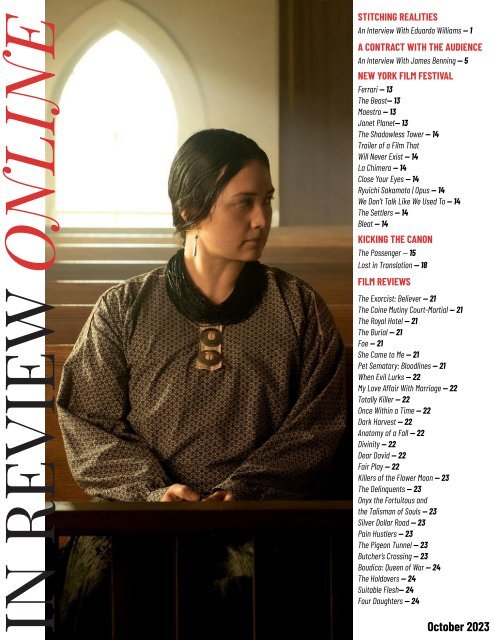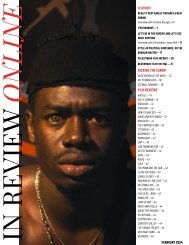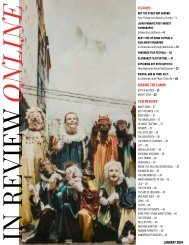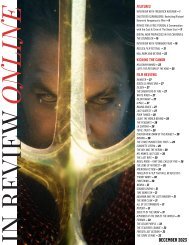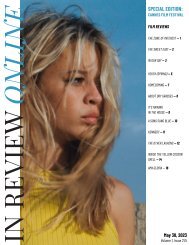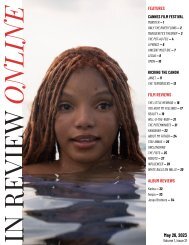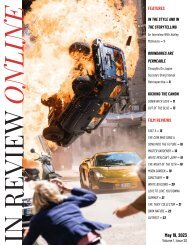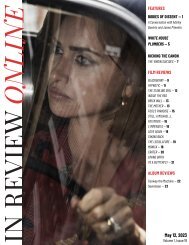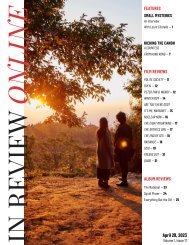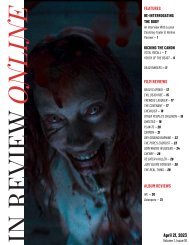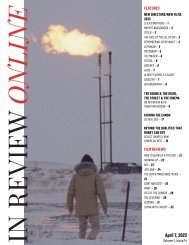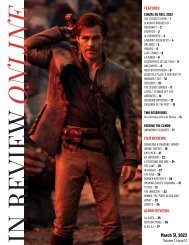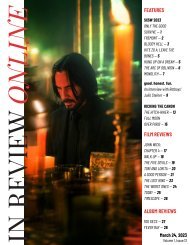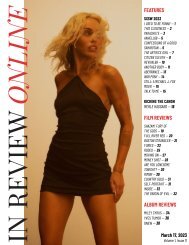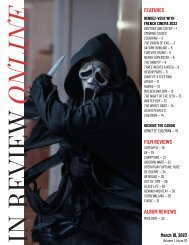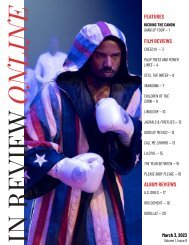InRO Monthly — October 2023
InRo Monthly
InRo Monthly
You also want an ePaper? Increase the reach of your titles
YUMPU automatically turns print PDFs into web optimized ePapers that Google loves.
IN REVIEW ONLINE<br />
STITCHING REALITIES<br />
An Interview With Eduardo Williams <strong>—</strong> 1<br />
A CONTRACT WITH THE AUDIENCE<br />
An Interview With James Benning <strong>—</strong> 5<br />
NEW YORK FILM FESTIVAL<br />
Ferrari <strong>—</strong> 13<br />
The Beast<strong>—</strong> 13<br />
Maestro <strong>—</strong> 13<br />
Janet Planet<strong>—</strong> 13<br />
The Shadowless Tower <strong>—</strong> 14<br />
Trailer of a Film That<br />
Will Never Exist <strong>—</strong> 14<br />
La Chimera <strong>—</strong> 14<br />
Close Your Eyes <strong>—</strong> 14<br />
Ryuichi Sakamoto | Opus <strong>—</strong> 14<br />
We Don’t Talk Like We Used To <strong>—</strong> 14<br />
The Settlers <strong>—</strong> 14<br />
Bleat <strong>—</strong> 14<br />
KICKING THE CANON<br />
The Passenger <strong>—</strong> 15<br />
Lost in Translation <strong>—</strong> 18<br />
FILM REVIEWS<br />
The Exorcist: Believer <strong>—</strong> 21<br />
The Caine Mutiny Court-Martial <strong>—</strong> 21<br />
The Royal Hotel <strong>—</strong> 21<br />
The Burial <strong>—</strong> 21<br />
Foe <strong>—</strong> 21<br />
She Came to Me <strong>—</strong> 21<br />
Pet Sematary: Bloodlines <strong>—</strong> 21<br />
When Evil Lurks <strong>—</strong> 22<br />
My Love Affair With Marriage <strong>—</strong> 22<br />
Totally Killer <strong>—</strong> 22<br />
Once Within a Time <strong>—</strong> 22<br />
Dark Harvest <strong>—</strong> 22<br />
Anatomy of a Fall <strong>—</strong> 22<br />
Divinity <strong>—</strong> 22<br />
Dear David <strong>—</strong> 22<br />
Fair Play <strong>—</strong> 22<br />
Killers of the Flower Moon <strong>—</strong> 23<br />
The Delinquents <strong>—</strong> 23<br />
Onyx the Fortuitous and<br />
the Talisman of Souls <strong>—</strong> 23<br />
Silver Dollar Road <strong>—</strong> 23<br />
Pain Hustlers <strong>—</strong> 23<br />
The Pigeon Tunnel <strong>—</strong> 23<br />
Butcher’s Crossing <strong>—</strong> 23<br />
Boudica: Queen of War <strong>—</strong> 24<br />
The Holdovers <strong>—</strong> 24<br />
Suitable Flesh<strong>—</strong> 24<br />
Four Daughters <strong>—</strong> 24<br />
<strong>October</strong> <strong>2023</strong>
STITCHING<br />
REALITIES<br />
An Interview With<br />
Eduardo Williams<br />
Argentinian filmmaker Eduardo Williams’ new<br />
film The Human Surge 3, which premiered this<br />
summer in competition at the Locarno Film<br />
Festival, is his first feature since The Human<br />
Surge. But there’s no missing second part, nor is<br />
the film a sequel, at least in the sense that it<br />
doesn’t rely on having seen the first film <strong>—</strong> nor<br />
continue its plot. What the two films share is an<br />
international set of performers and shooting<br />
locations, though the characters in the new film<br />
move much more freely between settings. The<br />
film also shares a shooting style with Williams’<br />
2019 short film Parsi, which was recently<br />
available to stream on Le Cinema Club. Both<br />
films were shot with 360° cameras and then<br />
framed in virtual reality by Williams after he cut<br />
the film together. The result is one of the most<br />
energizing two hours of the year, featuring some<br />
of the most novel images in recent memory. We<br />
spoke to Williams during the New York Film<br />
Festival, where The Human Surge 3 had its U.S.<br />
premiere.<br />
When you made the first film, The Human<br />
Surge, did you start out thinking about that<br />
as a project that might continue over<br />
multiple films? Or was there something<br />
afterward that made it feel like it was a<br />
project you wanted to continue?<br />
I mean, when I did The Human Surge, I didn’t<br />
think about having another film with the same<br />
title. So, it wasn’t a project in that sense. But at<br />
the same time, I see all my films as quite<br />
continuous, you know, and as the same project,<br />
they are very connected. So for me, it’s not a big<br />
surprise. But then, when I was thinking about<br />
what film to do after, I had the idea of naming it<br />
The Human Surge 3 because I realized that many<br />
of the ideas were very continuous. I also thought<br />
it was interesting to also go a bit against [the<br />
idea of] the notion of a single human surge; [if<br />
you have a first human surge and a third human<br />
surge,] there seem to be many possible human<br />
surges, let’s say.<br />
1
What were the specific ideas carrying over from the first film<br />
that led you to want to use the name again?<br />
I think a very simple and basic thing was the idea of making a film<br />
in several countries, in different continents. So this idea of<br />
connecting countries and people that I<br />
don’t see connecting so often, that was the basic thing. And then<br />
probably similar things that I was thinking about naturally, about<br />
my life and about many people’s life, like moving, transporting,<br />
using technology, how that changes our way of seeing everything;<br />
our relation with nature, and with everything that’s nonhuman, and<br />
other things like friendship and work. So I think in this one, I wanted<br />
to say, “okay, we have the same worries about the working world,”<br />
but also I wanted to go a bit further into the fantasy <strong>—</strong> or at least try<br />
to. So that was what I saw in continuation and evolution from the<br />
other one.<br />
Coming from a math background, when we’re mapping<br />
three-dimensional space in terms of rotation [which is to say,<br />
in the context of film, panning,] we can do it as a sphere or as<br />
a cylinder. The cylinder is nice in some ways because it’s<br />
closer to how we map two-dimensional space rotationally;<br />
we’re just adding in the up and down movement, but you have<br />
the rough edges in the up and down directions. The sphere then<br />
solves that problem in that it’s smooth all over, but it can be<br />
harder to conceptualize [or, as the three-dimensional space of<br />
this film captured by the 360-degree camera and then<br />
represented digitally, to program.] There are moments in this<br />
film where you do include that area directly above and below<br />
the camera, which I’d imagine is not designed so much to<br />
capture, so I wonder when you were doing the framing in VR if<br />
you felt more like you were looking around a sphere or a<br />
cylinder.<br />
I think in my experience I felt more in a sphere than in a cylinder,<br />
though it’s true that when I take the sphere to the screen, maybe it<br />
turns a bit more into an open cylinder. And then a sphere, I don’t<br />
know. But it’s true that what the camera creates is a sphere. So we<br />
see the stitches and lines when we look in front, but when we look<br />
up and down we see like a flower or a star, you know, where the<br />
eight cameras get together. So yeah, it was less smooth. But as you<br />
see in the film, I really liked that. So I tried to look there on purpose<br />
[at times,] and also I was thinking about what types of images to<br />
put there.<br />
We have a very important moment in the film where the camera<br />
spins. So there was also a circular energy that came to me very<br />
intuitively, like this desire of looking around that came because I<br />
could do it with this camera. And then thinking about it, I think it’s<br />
an important thing to have as the film advances; we started looking<br />
around more. And then in the spinning thing, we try to leave or<br />
break the image, let’s say, through [stitching]; I really liked this star<br />
or flower that was formed [through the stitching], although I think I<br />
could have tried to make the stitching there better. I don’t know if I<br />
could have done it totally invisible, but I didn’t even try because I<br />
really liked to see the seams in there.<br />
And then just before this, we have a very short segment of someone<br />
sleeping, and I put the camera on top of the person so the face<br />
would be in the stitching point below, where the eight cameras<br />
come together. And I realized when I saw this in my iPad, which is<br />
the direct streaming image, that we saw three faces. And when I<br />
stitched it afterwards, in the computer, this was lost. So I kept this<br />
preview image, which is the worst quality that you can get, because<br />
I really liked the three-faced living person that I would have lost if I<br />
made a better stitching. And at another moment, near the<br />
beginning, we have one face that is right in the stitching of two<br />
cameras, which is not below or under. And I knew that if you put the<br />
face very close to the camera, the camera couldn’t stitch very well.<br />
So we lost part of the face. And I really like this feeling of people<br />
blending into the digital image. So I used this, and in the end I did it,<br />
but artificially, so I generated the same deformation in the face of<br />
another actress. And in the moment I made the other actors react<br />
to this because I wanted to have this feeling of, okay, at the<br />
beginning we think this is just a glitch in the camera. And then we<br />
realize the actors, or the people we see, can see it. You know, we<br />
thought they couldn’t, but now we see they can.<br />
I have a couple of questions about the framing of the film and<br />
the post-production in VR. First, specifically in the scene you<br />
were talking about with the spinning, did you have to stand in<br />
the middle of the room and spin in a circle? Or is there just a<br />
button that you press and the image spins? And then more<br />
generally, how much time did having to do the framing, as well<br />
as the editing, during post-production add to the process?<br />
The spinning I made on the computer first, while I edited the two<br />
hours [of the film]. But it’s super fast, I couldn’t have spun so fast,<br />
so I added movement <strong>—</strong> I had the spinning already happening in the<br />
VR, but I added movement to that, slower movement, but still. I<br />
2
Something that I noticed both watching The Human Surge 3 and<br />
Parsi is this: when I’m watching a movie with subtitles <strong>—</strong><br />
whether it’s a movie in English where I just happen to have<br />
them on or a movie not in English where I need them to<br />
understand the dialogue, or when there’s a lot of overlapping<br />
dialogue (like in your films) <strong>—</strong> I’ll often see the subtitles pick<br />
out pieces of that dialogue so that it’s a reasonable amount to<br />
read. And I really like that the subtitles to your films embrace<br />
the chaos of the overlapping dialogue, such that all of the<br />
dialogue being spoken in the scene is on the screen for you to<br />
see, even if it’s more than most people could read. Do you take<br />
a really active role in doing the subtitling?<br />
3<br />
wanted to try to connect this computer movement to a more<br />
organic one. It’s a bit subtle, but I think it added something.<br />
And then how much time… I don’t know exactly how much time<br />
because really, I was doing everything at the same time. So while I<br />
was editing the sound, I was still framing. Also, after each shooting,<br />
I edited without the VR first because I couldn’t solve the problem of<br />
how to record my movement until the end. I mean, for Parsi<br />
[Williams’ previous film shot with a 360° camera] I could do it<br />
myself, but it was with a GoPro. So the image was easier for me [to<br />
work with] on my normal computer, and I just screen-captured the<br />
computer. But here I didn’t want to lose so much quality, so it was<br />
difficult to handle it on my own. So afterwards, we had a fund and<br />
we went to India to a post-production company called Media.Monks.<br />
And they made the system in Unreal, which recorded my movement<br />
and gave me keyframes that I could put in the good-quality image<br />
(because in the headset, you really cannot see these images in good<br />
quality). So I don’t know how much time it added; I would say maybe<br />
a month. I mean, I went for a week to India. And there they gave me<br />
the system in Unreal on a computer, and I could travel with that<br />
while I was doing the other post-production parts. It was very<br />
intense, working every day all day for almost a month: waking up,<br />
[working on the] computer until I fell asleep, and then again. It was<br />
also intense because I always try to do post-production a bit fast. I<br />
like to feel a bit of pressure about time.<br />
Yes, absolutely. For me, these moments are super important. As we<br />
know, translation can be very different. I mean, even if it’s the<br />
“correct” translation, you always have options. And sometimes for<br />
subtitles, you need to be more concrete [about your decisions];<br />
maybe you need to be shorter if you can while maintaining the<br />
same meaning. So it’s important for me to choose in which way [the<br />
dialogue is translated,] at least for the English subtitles; then for<br />
the other languages that I don’t know, I cannot. It was a very special<br />
thing to think about. At the beginning, I translated everything. But<br />
even if I liked the overlap there was too much. I mean, one of the<br />
reasons for doing that was that I thought if the spectators feel it’s<br />
too much to read then maybe I would invite them to stop reading<br />
for a while. I did the same thing in Parsi, in the moments where we<br />
have the poem and the dialogues of the people we see, but we can<br />
physically not read everything. So I was trying to say this here as<br />
well. Of course, some people still read all of it; it depends on your<br />
personality, how much you can not care about it or if you feel you<br />
really need to read. But I felt I had to reduce it a little bit, because it<br />
was maybe too much. I mean, I tried for it to be too much, but not<br />
so much, I don’t know [*laughs*]. So if you understand one of the<br />
languages, you can get a bit more, but it doesn’t change radically. I<br />
still try to keep, like, the general meaning of the conversations they<br />
were having. I just maybe took one or two phrases out to make it a<br />
bit less crazy.<br />
Yeah, and I think it works really well at emulating what the<br />
experience would be like if you understood one or more of the<br />
languages being spoken, and while at a certain point you pick<br />
up some of the meaning, the actual sound of the combined<br />
voices becomes just as important.<br />
Yeah, for me too.
I think with these emerging technologies like VR and 360°<br />
cameras we’ve seen a lot of technical demos, but there haven’t<br />
been a lot of users with the express goal of making cinema or<br />
art. Are there more ideas with these technologies you’d be<br />
interested in continuing to explore, or other new technologies<br />
you’re interested in employing?<br />
I mean, as you say, the most important thing for me about using<br />
these technologies was how I used them and why. And there were a<br />
lot of reasons with this film, but one main reason relates very much<br />
to a basic question we have in cinema, which is how to frame <strong>—</strong><br />
how we decide the frame of <strong>—</strong> a film. So in this case, I was moving<br />
the moment of the decision from the shooting to post-production.<br />
And also changing the state of mind [I was in]; you’re not in the<br />
same state of mind during shooting as in post-production, sitting<br />
alone in a room with time dedicated only to watching the images.<br />
So for me that’s the important thing, it’s not about technology so<br />
much as just how you use tools to think in a different way.<br />
But going forward, I’m not really sure. I have an idea <strong>—</strong> a very loose<br />
idea, I’m not exactly sure what I want to do next <strong>—</strong> but it doesn’t<br />
relate so much to a new technology as much as maybe a type of<br />
lens I’d like to use. In my mind, my ideal would be going back and<br />
forth, maybe using film and thinking if I’d use it in a different way<br />
now that I have all this experience working in virtual reality. In The<br />
Human Surge I used 16mm film as well as a small and a big video<br />
camera, and for me the idea was how would I use film with the<br />
mind of someone who watches YouTube videos as well as<br />
conventional films. In my mind that’s the question: how do we use<br />
both old and new technologies in the present?<br />
In my mind I won’t use VR and a 360° camera next, although maybe<br />
something happens and I change my mind. With Parsi I didn’t know I<br />
wanted to use VR, I just knew I needed a small cheap camera, and I<br />
started googling what are the small cheap cameras I could get, and<br />
then I saw the GoPro 360, and I wanted to use it because it was a<br />
good way of being able to give the camera to the actors without<br />
them having to think about framing. So the next time I’m working<br />
on a new project, I’ll probably also look on the Internet to see what I<br />
might be able to use.<br />
Have you gotten any opportunity since you started working<br />
with the 360° cameras to do more traditional work and see how<br />
your approach to that has changed?<br />
Not really. I made one installation for a museum called A Very Long<br />
.GIF, but that’s with a pill camera which isn’t traditional at all,<br />
though it’s also with a tele lens, which is more traditional <strong>—</strong> I like<br />
that combination of looking in our bodies and looking very far,<br />
within the same video. I’m not sure if it’ll really change or not, but<br />
it’s a curiosity I have. <strong>—</strong> INTERVIEW CONDUCTED BY JESSE<br />
CATHERINE WEBBER<br />
4
A CONTRACT WITH THE AUDIENCE<br />
An Interview With James Benning<br />
James Benning, the legendary moving-picture artist known for his durational portraits of America, has made one of his most personal<br />
works yet. Shot not too far from the cabins the artist reconstructed for his Two Cabins, Allensworth contains only twelve shots of a<br />
reconstructed version of California’s first town founded and run entirely by Black people that, years later, met an unjust end. Though a<br />
formal description may make Benning’s work seem simple <strong>—</strong> just as his Ten Skies (2004) might be described as “ten skies” <strong>—</strong> each minute<br />
spent with the work encourages the cogs in the viewer’s mind to turn on their own, allowing them to notice details that other filmmakers<br />
would’ve cut away from or to ponder the image’s relationship with the political history that birthed it.<br />
Benning himself notes in this interview that his simple approach forces a more engaged style of viewing <strong>—</strong> something quite rare in an age<br />
of political movies that opt for condescending exposition. Paying attention is good for both politics and art, so we talked to James Benning<br />
about both during his time at the New York Film Festival.<br />
You've been a teacher longer than you've been a filmmaker. Have you noticed a big difference recently in how different<br />
generations might approach art or what you teach?<br />
5
Oh, that's a really hard question. I've been making films for over 50<br />
years, so certainly it changes from day to day almost. When I<br />
began, I was connected to an avant-garde experimental film world<br />
influenced by Michael Snow and Hollis Frampton and less<br />
influenced by people like Brakhage, who made things that were<br />
more lyrical.<br />
I was more interested in the conceptual use of film. And now I'm<br />
very far away from that beginning. I'm kind of rooted in<br />
structuralism from the '70s, but I'm maybe more interested in the<br />
content that I'm putting in the film. And as far as students over the<br />
years, sure they've changed, just kind of like me, because the whole<br />
film world has become much wider, and I embrace the art world<br />
now more than the film world, so I tend to get students that are<br />
doing the same. So the kind of students I get today are almost the<br />
exact opposite of what I began with, and they're interested in those<br />
issues that are in the art world.<br />
I suspect that there's a little bit of self-selection with some of<br />
your students, though. That they might know what's going on if<br />
they choose to do a class with James Benning.<br />
Yeah, it's true, but we, at CalArts, tend to choose a lot of graduate<br />
students that maybe haven't even made films yet, that they're in<br />
the art world, or maybe they study mathematics, or history, but they<br />
have an interest in kind of expanding the film vocabulary. So, I tell<br />
them I don't want them to make another good film. We've had way<br />
too many of those. I'd like them to push the vocabulary and add to<br />
the film language. Which is a big challenge.<br />
Yeah, that's probably the best class I've ever taught. I continue to<br />
teach that, although it's getting more difficult because I'm not as<br />
mobile as I used to be. But I teach a variety of other classes that I<br />
enjoy, too. I teach a class called “Acting Bad,” where we deconstruct<br />
acting. It leans toward a kind of performance art. And I'm teaching<br />
a class on installation design this fall to allow students to design<br />
installation work without worrying about the amount of equipment<br />
they can get access to and the money. And then to pare down these<br />
kinds of grandiose proposals into something that's usable. So, this<br />
is a new class, and we've only taught it for two, three weeks now.<br />
But it seems like it's gonna be valuable.<br />
Do you think patience has declined thanks to the rise of things<br />
like smartphones, or kind of a constant stimulation? Do you<br />
think patience can be taught, either at a university level or just<br />
throughout one's lifetime?<br />
Well, I talk a lot about that, and I think through observation one<br />
gains agency. And I think just by talking about that concept that we<br />
can learn in different ways. You know, a mother can tell us<br />
something to do, or a cop can tell you what to do. You can read a<br />
book or whatever, but you can also look and listen.<br />
And that's really hard work. First, you have to even know you can do<br />
that to learn that it's an option of learning. And then once you know<br />
that, then you need to practice because it's a discipline to stay<br />
focused and to look at something for an hour to see how the light<br />
changes or to contemplate what are the social and political<br />
implications of a space.<br />
I'm curious if you've also noticed any kind of big bureaucratic<br />
changes that have taken place whenever it comes to teaching<br />
something like art or film.<br />
Like the outside world, everything is becoming morbid, and even in<br />
CalArts, which is a private school, those structures become<br />
top-heavy with administration. And it's only damaged the kind of<br />
freedom that I instill in students, you know. And then there's a lot of<br />
concern about lawsuits and providing students with information so<br />
they don't get into trouble. And I think to make good films, you<br />
almost have to get into trouble. So it's kind of a conflict.<br />
Do you have any favorite classes that you're teaching<br />
nowadays? I know you have that legendary "Seeing and<br />
Listening" class that everyone brings up.<br />
And then you can look things up and, you know, the actual<br />
observation can give you ideas as to which direction it goes. But, I<br />
think we're very far away from that because of the cell phones and<br />
things that are always distracting us. We have to have such<br />
discipline. The phone makes us look at it constantly. I don't have<br />
one, because I'm afraid I would just do that all the time. It is a trap.<br />
Friends of mine and myself <strong>—</strong> a lot of times we’ll select to go to<br />
movies in theaters simply because it can be so hard to watch<br />
movies or to engage with art at home with those distractions.<br />
But the theater has developed a contract with the audience that's<br />
stronger than real life. I can have a 10-minute shot of the moon<br />
rising, and people sit there and watch it. And, because they know<br />
when you come here, you actually do observe. But to get somebody<br />
6
to watch the moon rise outside for 10 minutes, they'll be looking at<br />
something else. You know, it's hard to stay focused. And it's an<br />
interesting thing now with installation art and installing films: that<br />
contract is much looser than the contract with the theater<br />
audience. So, that has to be developed too. Although, I think<br />
galleries and museums are perhaps much more social than viewing<br />
a film. So you go there to have a cup of coffee and you spend time<br />
<strong>—</strong> ten seconds <strong>—</strong> in front of each painting, and, you know, that<br />
contract has never been defined very strongly. But I think there are<br />
attempts now by artists and gallerists and museums that when you<br />
install work that has durational components, that somehow you<br />
have to allow the audience to know this is durational and you won't<br />
get it if you just watch it for 10 seconds.<br />
To get the people to do that is another thing. Now, I have a<br />
particular following, so if I do installation works, I'll get some of the<br />
people that know my films, knowing how to watch them. Others can<br />
be very difficult.<br />
How would you arrange the space in order to maybe<br />
communicate to somebody who wouldn't know your work that<br />
it would be durational? My first thought would be something<br />
like hiding it around a corner. I've seen museum installations<br />
where you hide a work around a corner and it's its own private<br />
space outside of the rest of the museum where you can engage<br />
with the art and leave on your own contract or will.<br />
Well, I don't really have an answer yet for that. But one is to just be<br />
straightforward and say this piece begins every hour on the hour,<br />
and it's durational and it lasts 45 minutes. Oh, and then it's also to,<br />
as when you build installations, consider this lack of contract and<br />
make work that can be seen just walking by.<br />
And then when they walk by another time, something else is<br />
happening. I've installed my film Twenty Cigarettes, and there it is<br />
without any explanation. And it's nice if it's at the beginning of a<br />
gallery space or museum. Because somebody will come in and<br />
7
there will be somebody smoking. And they might just see that same<br />
person and they walk around and they can pass it again and<br />
somebody else is smoking and then they look at it and then they<br />
come back. And then once you realize, oh, there's a number of<br />
people <strong>—</strong> maybe it draws you into it. But if I want an audience to<br />
actually experience it like in a theater, then I would have to have<br />
some kind of statement saying, you know, it starts at this time.<br />
So, one can have the different expectations of the installation: that<br />
you can have it so people actually watch it as a film, but then why<br />
not have it in the theater anyways? Or you can live with how it's<br />
viewed without any explanation. When I've installed [it like] that, I<br />
didn't expect people to watch the whole thing. I kind of like the idea<br />
that if it's near the end or beginning, people would pass it going in<br />
and out and see somebody else.<br />
Location is obviously a very important part of your work. I'm<br />
curious as to what your pre-production research process might<br />
be whenever you decide to film on a new location, and whether<br />
or not that varies whenever you're doing a project that's very<br />
specific to one location, like Allensworth, or perhaps something<br />
like North on Evers or The United States of America, where it's a<br />
much broader portrait.<br />
Yeah, it varies from film to film. I mean, the remake that I made of<br />
the U. S. A. that Bette Gordon and I made in 1975 was just crossing<br />
the U. S. with shots occasionally taken from the back of a car. And<br />
it played on one of <strong>—</strong> I can't remember, it was on streaming for a<br />
while [note: The United States of America briefly streamed on The<br />
Criterion Channel] and it got a great response.<br />
And then I thought, oh, I'll remake the film, but not really remake it.<br />
And then I just used the same title again. And for that, it was during<br />
Covid and I thought, well, I want to make a film that represents the<br />
whole U. S., but I don't want to travel that much during Covid, but I<br />
do want to get out of the house.<br />
8
And I know California worked very well, so I'll shoot everything in<br />
California. It'd be kind of a playful joke, and I reveal that at the end.<br />
But also, I thought it spoke to other things. How Hollywood movies<br />
do that all the time <strong>—</strong> where they are and where they're shooting.<br />
And then it became a kind of a fun project for me to find in<br />
California to represent Georgia, for instance.<br />
And then I realized that at one end of the county are my replicas,<br />
and then at the other end of the county there's this state park now<br />
that's replicated the town of Allensworth. So all of a sudden, my<br />
project was connected with that. And then it connected with my<br />
interest in how I've been fighting against the kind of prejudice that I<br />
grew up with.<br />
9<br />
Do you think that work has an anthropological element to it? I<br />
mean, it's mostly landscapes, but I feel like every once in a<br />
while we do see people and different kinds of people creating<br />
different kinds of environments.<br />
Well, Allensworth is a town that was built in the early 1900s in Tulare<br />
County, and it's in the Central Valley, which feeds a third of the U. S.<br />
with large corporate farms. And that happened after Allensworth<br />
was started in the early 1900s. And I was interested in that<br />
particular place because I'm interested in the evils of white culture<br />
toward Black culture.<br />
I grew up in a poor white ghetto in Milwaukee that was adjacent to<br />
the small Black ghetto. And I was being taught to hate Black people<br />
and that Black people hated us. We didn't know each other, but we<br />
did apply for the same job. So it was an institutionalized way to<br />
keep labor costs down and to keep the fighting in the poor part of<br />
town. So that took me some time to understand, that kind of<br />
systematic prejudice that I grew up in.<br />
So I've been trying to rid that from my system my whole life. And<br />
then when I found out about Allensworth, a town that had great<br />
promise, only it couldn't succeed mainly because of that [system].<br />
The way white culture made it very difficult for them. The land itself<br />
was sold to the Black people that were trying to start the town at a<br />
cost that was three times the rate of good land.<br />
And this was really poor land. And then the train was moved from<br />
their place to the close-by white town, so they lost that kind of<br />
revenue and distribution. And it goes on and on. They didn't get the<br />
water that they were promised when the irrigation systems were<br />
set up.<br />
In the end, the town fails. And then the town was rebuilt as a park,<br />
and that interested me because I have a place in Tulare County at<br />
the other end of the county that's up in the mountains. That’s where<br />
I built replicas of Thoreau's cabin and Kaczynski's cabin. So I have<br />
this as a kind of questioning of outsider-ness.<br />
So that all kind of connected and made me think, well, I'll just look<br />
at this place and see what I can learn from observing it. I thought of<br />
it as a mystery film where I wouldn't tell you anything about it. You<br />
would just observe it as if you stumbled onto this place. And then,<br />
through certain hints through sound and performance and poetry, I<br />
would give enough hints that you could kind of figure out what you<br />
might be looking at. And then in the end credits, there's a little more<br />
information. But hopefully, because everybody has these devices,<br />
they can look at it and can type in Allensworth and learn. So the film<br />
is a mystery film that gives you hints as to what it is, but it doesn't<br />
really completely describe it. But you can quickly find that<br />
information out. It's online, and now I've drawn great attention to<br />
that place. And to this event <strong>—</strong> the whole history of Allensworth.<br />
And it was a hidden history. So I'm hoping that the film does some<br />
teaching in that respect. But it doesn't do it itself. You have to be<br />
proactive and react to the film. And I think most people do that. And<br />
now it's got many reviews, and I'm really surprised. I was really<br />
pleased that almost everybody reviewing the film did extensive<br />
research about the place, and it's exactly what I wanted the film to<br />
do, so I think it's very successful in those terms.<br />
That's pretty good that you can have that secret pedagogy<br />
there to give them just enough information so that they want to<br />
learn more and teach themselves.<br />
That'd be the best way to do it. Otherwise, if I watch documentaries<br />
and they solve all the problems, I seem to think, okay, I know that,<br />
and then I never think about it again. So I have this opinion that<br />
documentaries should kind of motivate you. Some kind of activism.<br />
Be a participant within the film.<br />
How did you first come across the story of Allensworth? I was<br />
also going to ask how far it is from Val Verde, but it seems like<br />
it's closer to your cabins.<br />
Yeah, and it's not on the way between Val Verde and Pine Flat where<br />
I live at the moment, but it's directly west of the road that I go up<br />
into the mountains. When I come back down, if I don't turn on the
65 and keep going, I run right into Allensworth. So, my Two Cabins<br />
project is in a direct straight line with Allensworth. I stumbled on it<br />
just riding around Central Valley. I didn't know about it when I made<br />
El Valley Central.<br />
And then I stumbled across it 20 years ago. It happened to be on<br />
the day of the year that they celebrate the founding of it. So there<br />
were maybe 60 or 70 Black people there, and they were giving<br />
speeches, and I think there might have been one or two other white<br />
people at the time. So I was really surprised <strong>—</strong> it was an accident,<br />
basically.<br />
But then I didn't think about doing anything about it until so many<br />
years later after I had built my cabins, and then at some point it<br />
occurred to me: Oh, this fits exactly into what I've been struggling<br />
with my whole life. And so I've always been prepared to be kind of<br />
attacked by, I don't know, liberals I guess, that would say, oh, what<br />
right do you have to talk about Black people? But I'm not talking for<br />
Black people. I'm pointing the finger at the poor way white people<br />
act. So that's my interest: to point out these kinds of mistakes and<br />
how evil it is and what it can lead to.<br />
You say the town is a park now. So is there even a town that is<br />
operational and running?<br />
The park itself, no one lives there. And it's very spooky, and you kind<br />
of get that feeling from the film where you see one or two people in<br />
the whole film, and they're kind of hidden.<br />
The park is about two-thirds of what the town was. And so, south of<br />
the town, there's part of the [original] town, then there's a grade<br />
school there, and there's maybe 20 houses, and it's mainly, I think,<br />
Mexican at this time; maybe there's a few Black people. The<br />
graveyard is on the other side of that town <strong>—</strong> so the graveyard in<br />
Allensworth is outside of the park; it isn't part of the park, and it<br />
hasn't been restored. And it hasn't even been researched to figure<br />
out who's even buried there. It's just falling apart at this time.<br />
And I've gone there a number of times and I've met one of the Black<br />
10
11<br />
families that live in that part of Allensworth. And they were trying to<br />
raise money to do research to find out who is there and, at least,<br />
put it back into some kind of shape. But, it's still being used. There<br />
are a few graves that are only five or six years old there. But most<br />
of them are just little wooden crosses, no indication of who's buried<br />
there.<br />
The “December” shot in your film almost looked like a set,<br />
because the gravestone is still pretty legible, and then the<br />
crosses are set up in no order.<br />
And in the background of that shot, you can actually see some of<br />
the houses that are in the livable part of the town. But they're at a<br />
distance. And I think you hear a dog barking from there. And a plane<br />
flies overhead.<br />
Did you have to ask permission from the Parks Department? Or<br />
did you just show up and start filming?<br />
Well, the park is interesting, because I got stopped a few times. And<br />
the other interesting thing: the people who administer the park are<br />
all white. So, you know, it just continues on. They asked me what I<br />
was doing, and I just said that I'm interested in the place and I'm<br />
making a film to show my friends, you know.<br />
I showed the film at the Academy Museum in L. A., and there was a<br />
Black man who came to that screening that's connected with a<br />
group of Black people who are trying to have some say in<br />
Allensworth. And he liked the film a lot, and he wants me to show it<br />
at one of these yearly events there. So I'd like to do that.<br />
There are a couple of shots in this that I think are what you're<br />
referring to as these hints as to what is going on here. One is<br />
the big “August” shot with the student reading Lucille Clifton<br />
poetry where she's dressed like Elizabeth Eckford of the Little<br />
Rock Nine. And then you also have two songs: one's by Lead<br />
Belly, the other one Nina Simone. Was there anything that led<br />
you to those particular choices? Or did you want to just have<br />
some sort of rhyming with the bigger project of talking about<br />
Allensworth?<br />
Well, the two artists <strong>—</strong> I respect their work, and their own histories<br />
are interesting. Nina Simone is somebody who fled America<br />
because of racism, and that song is kind of brutal. So I thought it<br />
states what I'm interested in, the result of this kind of racism. And<br />
then Lead Belly <strong>—</strong> somebody who was let out of prison because he<br />
could make some music, and then had a song that Kurt Cobain<br />
made more famous than him <strong>—</strong> so it's this idea of Black culture
eing appropriated by white. He doesn't make money from it. So, I<br />
mean, I don't know if people watching it think about that, but it's in<br />
the film, it's something we can talk about.<br />
Also, the quality of the buildings themselves <strong>—</strong> and I'm guessing<br />
this has to do with the fact that it is a park now. They do look<br />
old, but they certainly don't look like they're from 1912.<br />
The choice to dress a student like Elizabeth Eckford <strong>—</strong> it's a<br />
very particular kind of outfit.<br />
I was very young when that picture was in the newspaper, and I was<br />
appalled by it. And that was kind of a beginning for me to start<br />
questioning. Because I could relate to this kid as a student, but I<br />
couldn't relate to going to high school the first day and having such<br />
stress, you know. And I thought, oh, this is what my neighborhood<br />
brings about, this kind of evilness.<br />
They were built from 1975 to '85. So they are like 40 years old and<br />
look like that. And some of them had just maybe been repainted a<br />
few years ago. Others, I’ve noticed they're repainting a lot of them<br />
this year. So it looks more like a park. Also, there’s the park rule<br />
about having wheelchair access. I had to try to shoot so I didn't<br />
quite show all the ramps that are in the place. And the interiors are<br />
all furnished with not the exact furniture that was in there, but of<br />
that period and that place. But, you can look in the windows, and<br />
once a year, I think they open the doors.<br />
So it's a reference to my own coming of age, kind of. But also, that<br />
photograph is kind of the quintessential meaning for what I've been<br />
struggling with my whole life. And it's such a beautiful dress. And<br />
that's such a tragic story for her because her family didn't have a<br />
telephone and the other eight students were alerted to enter the<br />
school from the back door, and she wasn't told. The information<br />
didn't get to her, so she was by herself confronted by this.<br />
I mean, I also feel bad for poor whites that, even today, a lot of<br />
Trump followers, when you have nothing, then you can be so easily<br />
manipulated. So it's kind of also a portrait of madness, that we have<br />
to look beyond who's actually yelling.<br />
I'm also curious about the structuring device of the film. It's<br />
separated into different months, but I think there's something<br />
interesting about that particular part of the California<br />
landscape. I suppose I was trying to look for the changes in<br />
maybe the flora or something. But I think the biggest visual<br />
indicator that the months are changing is maybe just the<br />
quality of light coming through.<br />
Yeah, California's upside-down because it's green in the winter and<br />
it's brown in the summer. So, in the very first shot, there's frost on<br />
the ground and there's actually green grass, but it's very muted<br />
because there's not much light. It's foggy that day. And then the<br />
next three or four shots are where you can see the grass getting<br />
greener in February, etc. And then by September, it's yellow, so it's<br />
the opposite. And there's not a lot of rain there. The rainy season is<br />
generally in the springtime. And so I had some cloudy days, but it<br />
was unusual for me to find it raining in <strong>October</strong>. But I took what I<br />
got.<br />
I took pictures through the window of the school and then I<br />
actually recreated the blackboard and the wainscoting exactly. So I<br />
made a replica of a replica, and shot it at school where I could have<br />
more control over things and didn't have to get permission to go<br />
inside.<br />
With digital technology developing so quickly and all kinds of<br />
new equipment coming out, do you find yourself trying to keep<br />
up with that <strong>—</strong> trying out new equipment and whatnot? Or do<br />
you have some standard digital tools that you like?<br />
Yeah, I shot on 16mm from 1970 to 2007, and I used two Bolexes: one<br />
was a hand-cranked Bolex, the other was an electric one that I put<br />
in a 400-foot magazine so I could do 11-minute shots. And I got<br />
familiar with that equipment and I liked it, and then it became<br />
impossible to get good lab work and I was forced into digital. I<br />
didn't go in until there was high definition digital.<br />
And so I bought a Sony camera in 2009, and it's just HD <strong>—</strong> I don't like<br />
4K. I’m still shooting HD because I don't like that ultra sharpness. 4K<br />
is great for if you're shooting at night or in darkness; you can get<br />
good quality in darker settings. But for what I do, I'm very happy<br />
with just HD, just the 1920x1080. I'm not trying to make films, but I<br />
think Allensworth almost looks like 35mm. It has kind of the same<br />
resolution. It isn't as sharp as 4K. I won't change that camera. I'm<br />
trying to keep it alive. So I've shot, I don't know, more films with that<br />
in 15 years than I shot [with the Bolexes] in 35 years. It's so cheap,<br />
and I made Allensworth for, I don't know, a thousand dollars. And<br />
that's just mainly gasoline. <strong>—</strong> INTERVIEW CONDUCTED BY ZACH<br />
LEWIS<br />
12
FERRARI<br />
Michael Mann<br />
“Perhaps Mann is attempting to find a<br />
more natural approach to shooting a<br />
digital period piece, one that flattens its<br />
inherent contradictions rather than<br />
heightening them, Public Enemies-style.<br />
Still, there are moments when the film<br />
feels like Mann simply and<br />
uncharacteristically transplanting his<br />
script to the screen. The images and<br />
textures captured by his 21st-century films<br />
aren’t just incidental <strong>—</strong> they’re the very<br />
essence of his cinema, invigorating and<br />
investigating his scripts at every turn, and<br />
Ferrari becomes somewhat more<br />
conventional in losing them.” <strong>—</strong> BRAD<br />
HANFORD<br />
THE BEAST<br />
Bertrand Bonello<br />
“Premonition, made sublunary thus, is<br />
proclaimed over in Bonello’s daringly sci-fi<br />
tour de force… What Bonello realizes so<br />
radically throughout these interwoven<br />
periods is how the malaise of the present<br />
forever haunts its visions of the future,<br />
just as how the future has always arrived,<br />
is always the age of unattainable nostalgia<br />
for the light. With stylistic precision and<br />
visual panache, he fashions a haunting<br />
metaphysical reverie of the human soul,<br />
condemned to meaning it cannot<br />
decipher.” <strong>—</strong> MORRIS YANG<br />
MAESTRO<br />
Bradley Cooper<br />
“Cooper attempts the high-wire act of<br />
appealing to the living children of his<br />
subjects (i.e., the estate), while also<br />
depicting Bernstein honestly and artfully,<br />
but he’s ultimately undone by this<br />
challenge, falling into a number of<br />
biopic-specific traps along the way<br />
(clumsy expository dialogue, undermining<br />
dramaturgy in favor of chronology, etc.).<br />
Maestro isn’t a totally starry-eyed<br />
depiction of Bernstein by any means, but<br />
the way it apologizes for and redeems<br />
him… feels unsatisfying and evasive, and<br />
at odds with what Cooper seemed to be<br />
angling for.” <strong>—</strong> M.G. MAILLOUX<br />
JANET PLANET<br />
Annie Baker<br />
“By and large, Baker avoids rendering<br />
objects with pat allegorical import. For<br />
example, the small figurines and detritus<br />
that dot the tiny stage in Lacy’s room are<br />
mementoes in the constructed play of her<br />
memory. Indeed, the image of a child<br />
overlooking ‘the little world’ of the stage is<br />
redolent of nothing less than Ingmar<br />
Bergman’s Fanny and Alexander. Baker<br />
earns the comparison without resorting to<br />
facile pastiche, as the film’s climactic<br />
moment also incorporates an enigmatic<br />
disappearance that teases the outer limits<br />
of magical realism without breaking its<br />
own inimitably cast spell.” <strong>—</strong> NICK KOUHI<br />
13
THE SHADOWLESS TOWER<br />
Zhang Lu<br />
“while Gu is central to the film narratively<br />
speaking, the true geographical center of<br />
[the film] is the White Pagoda, a<br />
13th-century structure that, it is said,<br />
casts its shadow many miles away in<br />
Tibet, but leaves no such impression in<br />
Beijing. This architectural anomaly speaks<br />
to the complicated place of Buddhism in<br />
the People’s Republic, but Zhang, even<br />
more than this, allows it to serve as a<br />
looming metaphor for a solitary life, for<br />
people who <strong>—</strong> for whatever reason <strong>—</strong><br />
refrain from making their presence felt in<br />
the lives of others. <strong>—</strong> MICHAEL SICINSKI<br />
TRAILER OF A FILM THAT<br />
WILL NEVER EXIST<br />
Jean-Luc Godard<br />
“The existence of the new Trailer For a<br />
Film That Will Never Exist: Phony Wars<br />
presents, then, a confounding (if<br />
extremely beautiful) object <strong>—</strong> a<br />
fragmented preview of a larger work that<br />
will never come to fruition, a suicide note,<br />
a communique from beyond the grave. <strong>—</strong><br />
DANIEL GORMAN<br />
LA CHIMERA<br />
Alice Rohrwacher<br />
“La Chimera is powered by such cycles of<br />
excavation and potential rebirth, during<br />
which Rohrwacher’s approach constantly<br />
shifts, jumping between three shooting<br />
formats and corresponding aspect ratios…<br />
and throwing in direct address and scenes<br />
of sped-up motion that resemble silent<br />
comedy. The effect is one of instability,<br />
where everything about Arthur’s situation<br />
feels tenuous, most of all his mercurial<br />
nature and wavering feelings about his<br />
profession, exacerbated<br />
by a potential new love in the<br />
suggestively-named Italia (Carol Duarte). <strong>—</strong><br />
RYAN SWEN<br />
CLOSE YOUR EYES<br />
Victor Erice<br />
“Close Your Eyes treats mise-en-scène in a<br />
way that allows the natural flow of the<br />
actors’ rhetorical abilities to play a crucial<br />
role in enhancing the whole of the film’s<br />
beguiling atmosphere. Utilizing plenty of<br />
various materials, from books to<br />
photographs, archival footage to movie<br />
posters, and even a couple of songs that<br />
assist Miguel’s (personal) investigations<br />
along the way, Erice’s unique visual<br />
regimen and tranquil narrative<br />
distributions embrace a very specific<br />
archeology of the past.”<strong>—</strong> AYEEN<br />
FOROOTAN<br />
RYUICHI SAKAMOTO |<br />
OPUS<br />
Neo Sora<br />
“Ryuichi Sakamoto | Opus achieves a<br />
similar phenomenological effect as light<br />
and shadow subtly morph the composer’s<br />
gaunt features and slender fingers.<br />
Watching Sakamoto play arpeggios, I was<br />
reminded of my own father playing the<br />
piano and subsequently seized with<br />
emotion. This empathic recognition of<br />
Sora’s haptic engagement with his father<br />
through his camera only enriched my<br />
appreciation for the artistic equilibrium<br />
achieved between both filmmaker and<br />
subject. <strong>—</strong> NICK KOUHI<br />
WE DON’T TALK LIKE WE<br />
USED TO<br />
Joshua Gen Solondz<br />
“We Don’t Talk Like We Used To proceeds<br />
with the manic energy of one recognizing<br />
FESTIVAL COVERAGE<br />
in the world what was previously known<br />
via instinct. If it’s a redoubling of his<br />
strategy, rather than a reinvention, it<br />
raises the question of post-pandemic art<br />
to the level of urgency. Covid didn’t reveal<br />
anything especially novel about society,<br />
but it did make pre-existing<br />
contradictions impossible to ignore. <strong>—</strong><br />
DYLAN ADAMSON<br />
THE SETTLERS<br />
Felipe Gálvez Haberle<br />
“A lush, elemental reckoning unfurls across<br />
the relatively condensed runtime of Felipe<br />
Gálvez Haberle’s debut, The Settlers, even if<br />
few of its proceedings strictly qualify as<br />
terse. In fact, the film’s tersest narrative<br />
developments are matched by a formal<br />
languor which, enveloping the<br />
mountainous landscapes of Patagonia<br />
alongside its portraits of fin de siècle<br />
colonialism, conjures the phantasmic<br />
imprints of a history hastily realized and<br />
therefore not quite resolved. <strong>—</strong> MORRIS<br />
YANG<br />
BLEAT<br />
Yorgos Lanthimos<br />
“If the spiritual dimensions of Bleat feel<br />
overly calculated, that may be because<br />
Lanthimos is a filmmaker who’s more<br />
comfortable in the realm of the senses.<br />
Goats aptly abound throughout the film,<br />
occupying a metaphorical parallel to the<br />
human figures driving the wisp-thin plot.<br />
Their presence calls attention to the<br />
peculiarity of human behavior, yet the<br />
brutal fate of one poor bovid seems<br />
distinctly informed by a vestigial echo of<br />
Greek antiquity. In this respect, Bleat<br />
yields a flash of historical specificity that’s<br />
refreshing in the wake of the director’s<br />
burgeoning overreliance on anachronism.”<br />
<strong>—</strong> NICK KOUHI<br />
14
KICKING THE CANON<br />
THE PASSENGER<br />
Michelangelo Antonioni<br />
Michelangelo Antonioni’s endlessly digressive Blow-Up (1966), the<br />
Italian director’s first of four films produced outside his home<br />
country, features a particular digression that links it directly to his<br />
final international production, The Passenger (1975). Blow-Up’s<br />
central character, Thomas, is a hot-shot fashion photographer<br />
living a materially successful but emotionally unfulfilling life in<br />
Swinging Sixties London. His dissatisfaction has many sources, but<br />
he <strong>—</strong> in a particularly unpredictable moment <strong>—</strong> links his emotional<br />
sickness to disdain for his job. He wants to escape (fashion)<br />
photography’s vanity; to, in his own words, “go off London” and be<br />
“free.” When his editor asks what he’ll do, though, he has no answer.<br />
In The Passenger, personal disillusionment from professional (and<br />
political) dissatisfaction is the film’s central conceit. Unlike Thomas,<br />
The Passenger’s protagonist <strong>—</strong> a war reporter doubling as<br />
something of a documentarian <strong>—</strong> seems to know what he will do<br />
when he’s free.<br />
This clarity, primarily political in nature, comes from the two other<br />
(de)tours Antonioni took between Blow-Up and The Passenger. The<br />
first one, Zabriskie Point (1970), is his most overtly political film. It’s<br />
an expensively mounted “fuck you” to America’s rapidly expanding<br />
consumerism of the late ‘60s. (The film’s original ending really did<br />
have a sky-plane writing, “Fuck You, America”; unsurprisingly, it was<br />
rejected.) Sympathizing with the counterculture movement of the<br />
time, its two protagonists <strong>—</strong> initially disillusioned in a<br />
characteristically Antonionian way <strong>—</strong> do attempt to implement their<br />
ideas, failing which they endeavor at least to dream about them in<br />
an explosively radical fashion. Chung Kuo, Cina, his three-part<br />
television documentary, is much less of a call-to-action film but<br />
rather a curiously self-reflexive and experiential work about the<br />
People’s Republic of China, made at the behest of Chairman Mao<br />
himself. Its depiction of the country and its Maoist values is,<br />
unsurprisingly, primarily positive, and only the narrator’s stray<br />
comments about their restricted access to major shooting locations<br />
qualify as an overt critique of the State’s now-documented<br />
totalitarianism.<br />
Despite (or perhaps because of) their political clarity, both these<br />
projects received heavy criticism, most dishearteningly <strong>—</strong> for<br />
Antonioni <strong>—</strong> by the leftist groups that he supported. His cinema of<br />
inaction conflicted with the era’s political activism in Zabriskie<br />
Point; his honest, matter-of-fact observations as a stranger to a<br />
foreign land in Chung Kuo, Cina included passages that didn’t<br />
conform to the picture-perfect depiction of Maoist China desired by<br />
the state. The anti-Antonioni reaction against the latter was<br />
especially vitriolic, with the Communist government banning the<br />
film in 1974. The Passenger was thus made when Antonioni was<br />
15 7 16
going through a phase of professional discontentment. Whether<br />
intentional or otherwise, it serves as an intersection of the other<br />
films: an idyllic common ground where Zabriskie Point and Chung<br />
Kuo, Cina’s political clarity greets Blow-Up’s ambiguity. At least,<br />
that’s where our protagonist, John Locke (Jack Nicholson), wishes<br />
to be. Burnt out from his passive role as a war reporter in Africa,<br />
Locke wants to “trade his identity” with that of David Robertson,<br />
another white man who’s an active participant in a radical<br />
separatist fight against what appears to be an authoritarian<br />
government in Chad. The details of the country’s political struggles<br />
and leaders are intentionally hazy; the active foreign participant<br />
remains distant in a war not involving himself. But is it possible for<br />
Locke to escape his discontented self and emerge into radical<br />
political consciousness?<br />
“[Antonioni’s] cinema of inaction,<br />
despite being endowed with<br />
concrete clarity, will always<br />
remain too fragile to become<br />
radically political.<br />
The film’s unforgettable opening twenty-five minutes answer this<br />
question in the most beguiling way. Its first eleven-minute stretch<br />
has Antonioni operating at the height of his power as a visual<br />
storyteller; almost everything about Locke’s role as the titular<br />
“passenger,” punctuated by his breaking point, is communicated<br />
visually. The Passenger’s very first shot depicts Locke as a stranger<br />
lost in a tiny village in the middle of the Saharan Desert.<br />
Cinematographer Luciano Tovoli uses an extreme wide shot, not so<br />
much to establish the film’s setting but to highlight our<br />
protagonist’s displaced, unimportant position within it. Antonioni<br />
repeatedly uses such long shots throughout this stretch to dwarf<br />
Locke’s presence within a space that’s alien to him, and he<br />
occasionally “forgets” to follow his protagonist <strong>—</strong> the camera pans<br />
or tracks before Locke motivates it. This “lag” is, arguably, the most<br />
apt representation of Locke’s helpless passivity as a foreigner, for<br />
even the camera, as much of a stranger to these surroundings as<br />
Locke, knows more than him and “drives” him toward the action.<br />
The final shot of this near-wordless eleven-minute sequence<br />
verbalizes what’s already been expressed quietly. Locke’s Jeep, the<br />
one thing he controls, also gets stuck in desert sand. He repeatedly<br />
tries to dig its tires out but ultimately gives up, falling to the ground<br />
and shouting, “All right! I don’t care!” It’s the only loud, declaratively<br />
KICKING THE CANON<br />
performative moment uncharacteristically tender of Nicholson’s<br />
onscreen presence, making his desperate cry for help here doubly<br />
impactful. Following which, he seeks an escape from passivity. This<br />
is the film’s pivotal sequence: Antonioni, narratively and formally,<br />
counters the opening eleven minutes’ stark, precisely stylized<br />
realism with an unflashy and hence even more hypnotic touch of<br />
surrealism. After returning to his hotel on foot, a physically and<br />
mentally exhausted Locke calls out for Robertson, and, upon<br />
entering his room, finds Robertson lying on his stomach on his bed,<br />
dead. Rummaging through the dead man’s belongings, Locke comes<br />
across his diary. As soon as he flips it open, we hear a soft but<br />
high-pitched beep fill the silence, somehow more calming than<br />
distracting. The absence of non-diegetic sound has played such a<br />
critical role in conveying Locke’s isolation until now, that its sudden<br />
presence pushes The Passenger, strangely, into a realm of<br />
(momentary) connection. The two-shot <strong>—</strong> of Locke looking at<br />
Robertson, thinking of becoming him <strong>—</strong> materializes this feeling<br />
conjured up by the mysteriously meditative note still percolating<br />
through the atmosphere.<br />
But once the music fades away, Locke still hasn’t decided whether<br />
he wants to become Robertson. As he continues to examine the<br />
similarities between his and Robertson’s passport photographs, an<br />
even more confounding non-diegetic audio track takes over: it’s the<br />
first conversation between the two men. The camera, initially<br />
focused on Locke’s face, begins to drift gently away from him,<br />
determined to fill in the visual absence of the voiceover, willing to<br />
bend the rules of space and time to open a literal and metaphorical<br />
window to the past. And yet, for every moment that tries to push<br />
past Locke’s passive reality, another instance pushes back. Even in<br />
this most transcendental sequence, Antonioni ensures that we, like<br />
Locke, don’t get carried away. He intercuts the magical intrusion of<br />
the past with the concrete reality of the present. The fluidity of<br />
moving from one moment to another, one identity to another, is<br />
undercut by showing the mechanical process of Locke cutting,<br />
replacing, and pasting his photo onto Robertson’s passport.<br />
Furthermore, the dialogue between the two men – initially perceived<br />
as a non-diegetic jolt to Locke’s desolate reality <strong>—</strong> is also<br />
demystified. Antonioni reveals the audio source to be Locke’s tape<br />
recorder <strong>—</strong> a device he plays to presumably convince himself of the<br />
possibility of escaping from himself.<br />
Antonioni’s screenplay (co-written by Mark Peploe, Peter Wollen, and<br />
Enrico Sannia) bifurcates the rest of The Passenger’s narrative to<br />
maintain this tension between Locke’s ability to become Robertson<br />
17<br />
16
KICKING THE CANON<br />
and his inability to unbecome himself. The former is the film’s<br />
driving narrative: Locke drifts from country to country, dutifully<br />
following Robertson’s meeting schedule to shape his identity bit by<br />
bit around him. He relocates from Chad to England, then to<br />
Germany, and finally to Spain, where he meets an unnamed young<br />
woman (the elusive Maria Schneider) who encourages him to keep<br />
following this path. But (narrative) speed bumps consistently<br />
disrupt Locke’s forward movement; the parallel narrative involves<br />
Rachel (Jenny Runacre), Locke’s estranged wife, piecing together<br />
the reasons behind her husband’s death. This search, more than a<br />
detailed investigation of her character, is representative of the<br />
consistent presence of John Locke, objective war reporter. In a<br />
way, it marks a grand narrativization of another moment in the film,<br />
when Locke-as-Robertson tells (or rather shows) the young woman<br />
that what he is running away from is also chasing him.<br />
The closer the impending collision gets, the less certain hitherto<br />
established things and places get. The Modernist buildings in<br />
Barcelona that the woman describes as “big enough for [Locke] to<br />
hide in for days” flatten into the sparse, desert terrain of Almería<br />
(also in Spain) that, yes, provides more room to move in, but also<br />
provides more vantage points for searching eyes to spot our<br />
protagonist’s movement. The silences and stillness, earlier symbols<br />
of peace and calm, also become signs of threat and tension. When<br />
the collision eventually happens, the feeling that dominates, even<br />
more so than uncertainty, is that of profound sadness. The<br />
penultimate six-minute take of The Passenger, now (rightfully)<br />
championed as a significant technical achievement, mirrors to<br />
some extent the initial sequence of identity transference between<br />
Locke and Robertson. But the movement in this shot is not towards<br />
an open window of infinite possibilities. It is, in fact, a circling back<br />
to the distanced, “objective” reality trapped inside a barred window.<br />
It is also, perversely enough, precisely the moment Locke becomes<br />
Robertson.<br />
The Passenger’s aching tragedy comes from its acknowledgment of<br />
our protagonist’s inability to escape his own self when he’s alive.<br />
People, as Locke describes it to Robertson in their first<br />
conversation, “translate every situation, every experience into the<br />
same old codes.” They are “creatures of habit,” unable to escape<br />
their constructed and rehearsed identities. For Locke, this means<br />
always remaining impartial, observing his and other lives from the<br />
sidelines. For Antonioni, there’s a dispiriting realization that there is,<br />
perhaps, no meeting ground between Blow-Up and Zabriskie Point or<br />
Chung Kuo, Cina. His cinema of inaction, despite being endowed<br />
with concrete clarity, will always remain too fragile to become<br />
radically political. But it’s precisely that fragility <strong>—</strong> a spontaneous<br />
moment of connection, a sudden realization of purpose, a<br />
momentary liberation from the burden of an otherwise mournfully<br />
futile world <strong>—</strong> that makes The Passenger feel hauntingly alive.<br />
Antonioni’s failed search for permanent escape provides us, in the<br />
strangest way possible, with a reason to try. <strong>—</strong> DHRUV GOYAL<br />
17
KICKING THE CANON<br />
LOST IN<br />
TRANSLATION<br />
Sofia Coppola<br />
When was the last time you visited a foreign city and didn’t look up<br />
things to do? Didn’t crowd-source recommendations, rely on offline<br />
maps and translate apps, or post a constant stream of pictures and<br />
videos? Didn’t even take them, maybe? These days, it's tough to<br />
even go out to lunch in one's own neighborhood without looking up<br />
options ahead of time. But in 2003, when Sofia Coppola’s<br />
sophomore feature Lost in Translation was released, iPhones didn’t<br />
exist; instead, people sent faxes or drew maps by hand.<br />
Experiences were meant to be enjoyed, not documented. <strong>2023</strong><br />
marks the film’s 20th anniversary, its famously (and perhaps<br />
frustratingly) sparse plot all the more poignant when we consider<br />
how much has changed in those intervening years.<br />
Bill Murray, in a role written with him in mind, stars as Bob Harris, a<br />
washed-up actor who pads his bank account with lucrative but<br />
mind-numbing commercial work and is staring down the wrong side<br />
of middle age. He’s in Tokyo to shoot a Suntory Whisky ad, staying in<br />
the same hotel as the much younger Charlotte (Scarlett Johansson)<br />
and her photographer husband John (Giovanni Ribisi, loosely based<br />
on Coppola’s ex, Spike Jonze). Harris is sullen and sarcastic, a<br />
fading star with a faltering marriage and a career that’s running on<br />
fumes. But even if he were pulling in more substantial work, he’d<br />
probably still be a bit of a loner. Even though Murray plays him as a<br />
generally surly crank, he finds an almost tender inner core: a tired,<br />
unhappy man whose impatience is in direct<br />
18
19<br />
KICKING THE CANON<br />
proportion to his own shortcomings. As a result, he comes across<br />
as somewhat non-threatening, even a little silly <strong>—</strong> the bumbling<br />
tourist doing the bare minimum, not out of disrespect but because<br />
he knows no one expects anything more substantial. In this light,<br />
even his cringiest interactions with the locals come across as more<br />
boorish than intentionally racist, though some critics and<br />
audiences have certainly pushed back against that interpretation.<br />
While John is off on assignments, Charlotte, a recent Yale<br />
philosophy grad, wanders around the drizzly Tokyo springtime or<br />
listens to self-help CDs. She’s frequently perched against her room’s<br />
massive windows, trying to figure out where she belongs in the city<br />
below. Johansson, who was 17 during production, delivers a<br />
vulnerable, yearning performance that conveys the helplessness of<br />
someone whose estimation of their sense of self outpaces reality.<br />
She’s old enough to be a wife, but too young to articulate her<br />
unhappiness in any real terms <strong>—</strong> instead, she tells a friend that<br />
“John’s using these hair products. I don’t know who I married!” After<br />
visiting a Buddhist temple, she breaks down and cries,<br />
overwhelmed not by emotion, but by her own apathy. This<br />
manifests day-to-day as snobbery, especially at the expense of<br />
John’s ditsy client Kelly (Anna Faris, whose performance was<br />
supposedly based on Cameron Diaz). “I’m so mean”, Charlotte frets<br />
as she and Bob lay in bed, fully clothed, talking. “You’re not<br />
hopeless,” he replies: not refuting her claim, but nonetheless<br />
offering reassurance.<br />
Coppola foregrounds the interpersonal and cultural<br />
misunderstandings implied in the film’s title, whether it concerns a<br />
semi-hysterical prostitute who’s sent to Bob’s room or the dandyish<br />
Suntory director, who gives comically lengthy directions only for the<br />
translator to pass along two sentences. But underneath these<br />
surface-level misunderstandings is a cache of the deeper, more<br />
liminal stuff that Bob and Charlotte, along with viewers, spend the<br />
film trying to access and articulate. Separately and then together,<br />
they struggle to grasp the limits of their own understanding.<br />
Hovering just beyond their sight lines are the things they want to<br />
understand and know they never will. At least, not without levels of<br />
dedication and commitment and humility that currently seem<br />
beyond their reach. Coppola doesn’t ask them to make any<br />
decisions, but instead allows them come to the realization that, one<br />
day, they’ll have to. Look at Bob and his wife Lydia, who, like many<br />
long-married couples, seem to love but not particularly like each<br />
other. Or John, who often clutches Charlotte, squid-like, as she<br />
squirms out of reach. Since their absent spouses seem to have<br />
little regard for (or even interest in) their counterparts’ interior life,<br />
the film’s emotional core is the off-kilter acceptance Bob and<br />
Charlotte manage to find in each other.<br />
In many ways, Lost in Translation’s autobiographical slant and<br />
quasi-romantic depiction of both youthful and middle-aged<br />
aimlessness presaged a slew of other critically successful<br />
autofictions, even across mediums; two of the more instructive<br />
examples include Karl Ove Knausgaard’s My Struggle series (the first<br />
volume published in 2009) and Ben Lerner’s debut novel Leaving the<br />
Atocha Station (2011). In the former, Knausgaard transcribes and,<br />
one presumes, embellishes his memories and experiences in<br />
almost excruciating detail. Over 6 lengthy volumes, the deeply<br />
personal act of remembering becomes an overtly exhibitionist<br />
activity, his most personal experiences transformed into dinner<br />
party fodder for the self-consciously highbrow. Meanwhile, Adam<br />
Gordon, Lerner’s fictional analog, is a young poet on a writing<br />
fellowship in Madrid, where he masks his deficient language skills<br />
with a form of culturally transcendent intellectual posturing that<br />
requires the implicit <strong>—</strong> and perhaps unknowing <strong>—</strong> participation of<br />
his Spanish girlfriend, Isabel. Their conversations have almost<br />
nothing to do with actual communication; instead, Lerner scaffolds<br />
elaborate layers of presumed meaning that hinge on what he hopes<br />
is her idea of him: “[she] assigned profound meaning to my<br />
fragmentary speech… and because she projected what she thought<br />
she discovered… she experienced, I like to think, an intense affinity<br />
for the workings of my mind.” Of course, he can’t ask her outright if<br />
this is the case, nor does he actually want to know the truth. For<br />
him, these mistranslations are more meaningful than the banality<br />
of genuine connection <strong>—</strong> yet his naked desire to be respected and<br />
admired is its own form of honesty.<br />
“Lost in Translation’s<br />
autobiographical slant and<br />
quasi-romantic depiction of both<br />
youthful and middle-aged<br />
aimlessness presaged a slew of<br />
other critically successful<br />
autofictions.<br />
Like these and many other contemporary narratives, Lost in<br />
Translation hums with a now-familiar vein of postmodern<br />
melancholy. Bob and Charlotte are stuck in a discomfitingly familiar
KICKING THE CANON<br />
paradox: their lives are marked by a lack of urgency or forward<br />
momentum, even as they’re glumly aware of time passing. Bob is<br />
missing his young son’s birthday to shill whiskey, while Charlotte is<br />
simply there, tagging along. But when John goes away on<br />
assignment for a couple of days, the unlikely pair finally get a<br />
chance to shake off their inertia. After meeting up with a couple of<br />
her friends, they have the sort of exuberant, serendipitous late<br />
night, the kind that can never be replicated, only cherished in the<br />
moment. They get chased out of a trendy bar by a stranger with a<br />
stun gun; they run through an arcade, in one of many sequences<br />
that highlight the city’s gorgeous neon palette; they wind up at a<br />
house party, then a high-rise karaoke den, where they serenade<br />
each other off-key. Along the way, Charlotte acquires a pale pink<br />
wig.<br />
In other words, it’s the sort of night that increasingly seems to exist<br />
outside time, and certainly outside modern technology; nowadays,<br />
people would be snapping pics, adding each other on socials,<br />
Shazaming the music. Instead, Coppola presents an organic ebb<br />
and flow of strangers, laughing and drinking and singing to each<br />
other with no expectations for anything deeper or longer-lasting<br />
than this one shared and delirious night. And in each other, Bob and<br />
Charlotte find something more valuable than sex: companionship.<br />
Marooned and alone in this densely packed city, they forge a<br />
connection that’s intimate but never illicit. In fact, its chasteness<br />
casts it even more special, because that’s what makes it so<br />
unexpected and irreplicable. Their relationship is platonic and,<br />
above all, co-conspiratorial; by the time they part ways in the film’s<br />
enigmatic final scene, their brief time together has changed them<br />
both. It’s not a sentimental goodbye <strong>—</strong> they don’t exchange contact<br />
info or pledge to be better people. Audiences don’t even know what<br />
Bob whispers when they embrace for the last time because the<br />
dialogue is purposely inaudible. Once again, any understanding of<br />
their relationship is tantalizingly out of reach to everyone but<br />
themselves. Despite all the technology now at our disposal, there<br />
are still some secrets that are better left unshared. <strong>—</strong> SELINA LEE<br />
20
FILM REVIEWS<br />
RELEASE DATE: OCTOBER 6<br />
THE EXORCIST: BELIEVER<br />
David Gordon Green<br />
“The most grievous sin committed by The Exorcist: Believer is how<br />
rank dull it all is. On the most basic of levels, the film fails to<br />
quicken the pulse or truly shock the viewer. There’s nothing<br />
particularly transgressive or gutting about the possession of the<br />
girls <strong>—</strong> the sexualization of tweens has become such a third rail in<br />
recent years that even demons know not to touch it <strong>—</strong> and as<br />
neither they nor their parents register as living, breathing creations,<br />
their torment is strictly academic. Further, Green’s filmmaking is<br />
entirely anonymous, skimping on sustained dread and malevolent<br />
atmosphere in favor of jump scares… hurtling along from incident<br />
to incident, with nary a moment to reflect or allow the enormity of<br />
the subject matter to permeate.” <strong>—</strong> ANDREW DIGNAN<br />
DIRECTOR: David Gordon Green; CAST: Leslie Odom Jr., Ellen<br />
Burstyn, Olivia O'Neill, Ann Dowd, Lidya Jewett; DISTRIBUTOR:<br />
Universal Pictures; IN THEATERS: <strong>October</strong> 6; RUNTIME: 2 hr. 1 min.<br />
THE CAINE MUTINY COURT-MARTIAL<br />
REVIEW BY: Liam Kenny; DIRECTOR: William Friedkin; CAST:<br />
Kiefer Sutherland, Jason Clarke, Jake Lacy, Monica Raymond;<br />
DISTRIBUTOR: Showtime; STREAMING: <strong>October</strong> 6; RUNTIME: 1 hr.<br />
48 min.<br />
FOE<br />
REVIEW BY: Andrew Dignan; DIRECTOR: Garth Davis; CAST: Paul<br />
Mescal, Saoirse Ronan, Aaron Pierre, Jordan Choziesner;<br />
DISTRIBUTOR: Amazon Studios; IN THEATERS: <strong>October</strong> 6;<br />
RUNTIME: 1 hr. 50 min.<br />
THE ROYAL HOTEL<br />
REVIEW BY: Andrew Dignan; DIRECTOR: Kitty Green; CAST: Julia<br />
Garner, Jessica Henwick, Hugo Weaving, James Frecheville, Daniel<br />
Henshall; DISTRIBUTOR: NEON; IN THEATERS: <strong>October</strong> 6;<br />
RUNTIME: 1 hr. 31 min.<br />
SHE CAME TO ME<br />
REVIEW BY: Travis DeShong; DIRECTOR: Rebecca Miller; CAST:<br />
Anne Hathaway, Peter Dinklage, Marisa Tomei, Brian d'Arcy James,<br />
Joanna Kulig; DISTRIBUTOR: Vertical; IN THEATERS: <strong>October</strong> 6;<br />
RUNTIME: 1 hr. 42 min.<br />
THE BURIAL<br />
REVIEW BY: Andrew Dignan; DIRECTOR: Maggie Betts; CAST:<br />
Tommy Lee Jones, Jamie Foxx, Jurnee Smollett, Mamoudou Athie;<br />
DISTRIBUTOR: Amazon Studios; IN THEATERS: <strong>October</strong> 6;<br />
STREAMING: <strong>October</strong> 13; RUNTIME: 2 hr. 6 min.<br />
PET SEMATARY: BLOODLINES<br />
REVIEW BY: Steven Warner; DIRECTOR: Lindsey Anderson Beer;<br />
CAST: Forrest Goodluck, Jackson White, Henry Thomas, Natalie Alyn<br />
Lind, Isabella LaBlanc; DISTRIBUTOR: Paramount+; STREAMING:<br />
<strong>October</strong> 6; RUNTIME: 1 hr. 24 min.<br />
21
WHEN EVIL LURKS<br />
REVIEW BY: Andrew Dignan; DIRECTOR: Demián Rugna; CAST:<br />
Ezequiel Rodríguez, Demián Salomon, Silvina Sabater, Paula<br />
Rubinsztein; DISTRIBUTOR: IFC Films; IN THEATERS: <strong>October</strong> 6;<br />
STREAMING: <strong>October</strong> 27; RUNTIME: 1 hr. 39 min.<br />
MY LOVE AFFAIR WITH MARRIAGE<br />
FILM REVIEWS<br />
REVIEW BY: Joshua Minsoo Kim; DIRECTOR: Signe Baumane;<br />
CAST: (voices) Dagmara Domińczyk, Matthew Modine, Stephen Lang,<br />
Cameron Monaghan; DISTRIBUTOR: 8 Above; IN THEATERS:<br />
<strong>October</strong> 6; RUNTIME: 1 hr. 48 min.<br />
TOTALLY KILLER<br />
Nahnatchka Khan<br />
“The best film that Blumhouse and Amazon have delivered since<br />
joining forces in 2020 for an annual <strong>October</strong> scarefest. That bar has<br />
admittedly been set quite low so far in the young collaboration, but<br />
in a genre increasingly inclined toward the leaden, having some<br />
legitimate, lightweight fun with one of these ventures is no thing to<br />
turn your nose up at. Here’s to the next batch.” <strong>—</strong> STEVEN WARNER<br />
DIRECTOR: Nahnatchka Khan; CAST: Kiernan Shipka, Olivia Holt,<br />
Julie Bowen, Randall Park; DISTRIBUTOR: Amazon Studios;<br />
STREAMING: <strong>October</strong> 6; RUNTIME: 1 hr. 43 min.<br />
RELEASE DATE: OCTOBER 13<br />
ONCE WITHIN A TIME<br />
REVIEW BY: Michael Sicinski; DIRECTOR: Godfrey Reggio; CAST:<br />
Mike Tyson, Brian Belott, Sussan Deyhim, Aaron Kingsley Adetola;<br />
DISTRIBUTOR: Oscilloscope; IN THEATERS: <strong>October</strong> 13; RUNTIME:<br />
52 min.<br />
DIVINITY<br />
REVIEW BY: Conor Truax; DIRECTOR: Eddie Alcazar; CAST: Stephen<br />
Dorff, Bella Thorne, Scott Bakula, Caylee Cowan, Moises Arias;<br />
DISTRIBUTOR: Utopia; IN THEATERS: <strong>October</strong> 13; RUNTIME: 1 hr 28<br />
min.<br />
DARK HARVEST<br />
REVIEW BY: Daniel Gorman; DIRECTOR: David Slade; CAST: Casey<br />
Likes, Emyri Crutchfield, Elizabeth Reaser, Jeremy Davies;<br />
DISTRIBUTOR: MGM; IN THEATERS: <strong>October</strong> 11; STREAMING:<br />
<strong>October</strong> 13; RUNTIME: 1 hr. 20 min.<br />
ANATOMY OF A FALL<br />
REVIEW BY: Morris Yang; DIRECTOR: Justine Triet; CAST: Sandra<br />
Hüll, Swann Arlaud, Milo Machado Graner, Antoine Reinartz;<br />
DISTRIBUTOR: NEON; IN THEATERS: <strong>October</strong> 13; RUNTIME: 2 hr. 32<br />
min.<br />
DEAR DAVID<br />
REVIEW BY: Emily DuGranrut; DIRECTOR: John McPhail; CAST:<br />
Augustus Prew, Justin Long, Andrea Bang; DISTRIBUTOR: BuzzFeed<br />
Studios, Lionsgate; IN THEATERS: <strong>October</strong> 13; RUNTIME: 1 hr 34<br />
min.<br />
FAIR PLAY<br />
REVIEW BY: Andrew Dignan; DIRECTOR: Chloe Domont; CAST:<br />
Phoebe Dynevor, Alden Ehrenreich, Eddie Marsan, Rich Sommer;<br />
DISTRIBUTOR: Netflix; IN THEATERS: September 29; STREAMING:<br />
<strong>October</strong> 6; RUNTIME: 1 hr. 53 min.<br />
22
FILM REVIEWS<br />
RELEASE DATE: OCTOBER 20<br />
KILLERS OF THE FLOWER MOON<br />
Martin Scorsese<br />
“though Lily Gladstone gives a performance worthy of the<br />
unanimous praise, this isn’t a film about Mollie Burkhart. While she<br />
is the only character who’s rewarded with a rich interior monologue<br />
(that acts as a moral guide throughout the film), Scorsese focuses,<br />
as he always does, on the people who fuck it all up. One may be<br />
tempted to see Scorsese’s protagonists as an ever-evolving portrait<br />
of American criminality, from the footmen of Mean Streets to the<br />
mid-level mob families of Goodfellas to the legitimized crime<br />
business of Casino to the fully “respectable” criminal enterprise of<br />
The Wolf of Wall Street… With Killers of the Flower Moon, Scorsese<br />
has taken his journey’s final step by circling back, telling the story<br />
of the snakes and coyotes and wolves that stole a nation and its<br />
spirit.” <strong>—</strong> ZACH LEWIS<br />
DIRECTOR: Martin Scorsese; CAST: Leonardo DiCaprio, Robert De<br />
Niro, Lily Gladstone, Jesse Plemmons; DISTRIBUTOR: Paramount<br />
Pictures; IN THEATERS: <strong>October</strong> 20; RUNTIME: 3 hr. 26 min.<br />
23<br />
THE DELINQUENTS<br />
REVIEW BY: Jesse Catherine Webber; DIRECTOR: Rodrigo Moreno;<br />
CAST: Daniel Elías, Esteban Bigliardi, Margarita Molfino;<br />
DISTRIBUTOR: Mubi; IN THEATERS: <strong>October</strong> 16; RUNTIME: 3 hr. 9<br />
min.<br />
ONYX THE FORTUITOUS AND THE TALISMAN OF<br />
SOULS<br />
REVIEW BY: Luke Gorham; DIRECTOR: Andrew Bowser; CAST:<br />
Andrew Bowser, Jeffrey Combs, Olivia Taylor Dudley, Barbara<br />
Crampton; DISTRIBUTOR: Cineverse; IN THEATERS: <strong>October</strong> 19;<br />
RUNTIME: 1 hr. 48 min.<br />
SILVER DOLLAR ROAD<br />
REVIEW BY: Michael Sicinski; DIRECTOR: Raoul Peck; CAST: <strong>—</strong>;<br />
DISTRIBUTOR: Amazon Studios; IN THEATERS: <strong>October</strong> 13;<br />
STREAMING: <strong>October</strong> 20; RUNTIME: 1 hr. 40 min.<br />
PAIN HUSTLERS<br />
REVIEW BY: Andrew Dignan; DIRECTOR: David Yates; CAST: Emily<br />
Blunt, Chris Evans, Catherine O'Hara, Chloe Coleman, Andy Garcia;<br />
DISTRIBUTOR: Netflix; STREAMING: <strong>October</strong> 27; RUNTIME: 2 hr. 2<br />
min.<br />
THE PIGEON TUNNEL<br />
REVIEW BY: Chris Mello; DIRECTOR: Errol Morris; CAST: Jake Dove,<br />
Charlotte Hamblin, Garry Cooper, Simon Harrison, Douglas Rankine;<br />
DISTRIBUTOR: Apple TV+; STREAMING: <strong>October</strong> 20; RUNTIME: 1 hr.<br />
32 min.<br />
BUTCHER’S CROSSING<br />
REVIEW BY: Paul Attard; DIRECTOR: Gabe Polsky; CAST: Nicolas<br />
Cage, Rachel Keller, Jeremy Bobb, Paul Raci, Xander Berkeley;<br />
DISTRIBUTOR: Saban Films; IN THEATERS: <strong>October</strong> 26; RUNTIME: 1<br />
hr. 45 min.
FILM REVIEWS<br />
RELEASE DATE: OCTOBER 27<br />
BOUDICA: QUEEN OF WAR<br />
Jesse V. Johnson<br />
“[At times] the film approaches the austerity of Rivette’s Joan the<br />
Maid duology, or even Bresson’s Lancelot du Lac. Everything Johnson<br />
chooses to put on screen is essential, even if because of practical<br />
necessity rather than “artistry.” But the end result is the same <strong>—</strong><br />
everything superfluous is simply cast aside. There’s a kind of<br />
beauty to the formal and moral simplicity on display, as Kurylenko<br />
splits the difference between Renee Falconetti and Milla<br />
Jovovich-type action hero. As the saying goes, your mileage may<br />
vary, but for those inclined to embrace the bootstrap ethos of DTV,<br />
Boudica is a fist-pumping delight.” <strong>—</strong> DANIEL GORMAN<br />
DIRECTOR: Jesse V. Johnson; CAST: Olga Kurylenko, Clive Standen,<br />
Peter Franzén; DISTRIBUTOR: Saban Films; IN THEATERS &<br />
STREAMING: <strong>October</strong> 27; RUNTIME: 1 hr. 40 min.<br />
THE HOLDOVERS<br />
REVIEW BY: Jesse Catherine Webber; DIRECTOR: Alexander Payne;<br />
CAST: Paul Giamatti, Da'Vine Joy Randolph, Dominic Sessa;<br />
DISTRIBUTOR: Focus Features; IN THEATERS: November 10;<br />
RUNTIME: 2 hr. 13 min.<br />
SUITABLE FLESH<br />
REVIEW BY: Morris Yang; DIRECTOR: Joe Lynch; CAST: Heather<br />
Graham, Judah Lewis, Barbara Crampton; DISTRIBUTOR: RLJE<br />
Films; IN THEATERS: <strong>October</strong> 27; RUNTIME: 1 hr. 40 min.<br />
FOUR DAUGHTERS<br />
REVIEW BY: Dhruv Goyal; DIRECTOR: Kaouther Ben Hania; CAST:<br />
Hend Sabry; DISTRIBUTOR: Kino Lorber; IN THEATERS: <strong>October</strong> 27;<br />
RUNTIME: 1 hr. 47 min.<br />
24
Photo Credits:<br />
Cover - Melinda Sue Gordon/Apple Original Films; Page 1 - Norman Wong; Page 3 - Courtesy of<br />
Rediance; Page 4 - Courtesy of Rediance; Page 5 - Sharon Lockhart; Page 7 - Courtesy of the<br />
artist; Page 8 - James Benning; Page 10 - Courtesy of the artist and neugerriemschneider, Berlin;<br />
Page 11 - Courtesy of the artist and neugerriemschneider, Berlin; Page 13 - NYFF, Courtesy of<br />
Lorenzo Sisti/Forward Pass; Page 15 - MGM; Page 17 - MGM/Mubi; Page 18 - Focus Features; Page<br />
20 - Focus Features; Page 21 - Universal Pictures; Page 22 - Prime Video; Page 23 - AppleTV+;<br />
Page 24 - Signature Entertainement/Saban Films; Back Cover - Deborah Stratman/Film at Lincoln<br />
Center


